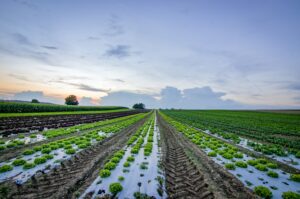 Regenerative agriculture is becoming the latest topic in sustainability—but it is far more than just a buzzword or passing trend.
Regenerative agriculture is becoming the latest topic in sustainability—but it is far more than just a buzzword or passing trend.
The Rodale Institute defines regenerative agriculture as “a system of farming principles that rehabilitates the entire ecosystem and enhances natural resources, rather than depleting them.” Broadly speaking, regenerative practices aim to transform modern agriculture to ensure the long-term health of the planet.
As consumers continue to demand environmentally friendly products and become more educated about sustainability, regenerative agriculture has come to the forefront as a priority. Several major businesses in the consumer goods industry are making commitments to ensure regenerative practices in their supply chains in the next decades.
A complete overhaul
In a normal healthy system, plants draw carbon out of the air through photosynthesis, converting it to energy for growth. Any excess carbon is stored in soil, which also helps give soil its water-retention capacity, structure, and fertility. However, the conventional farming practices used today, such as monocultures, intensive tillage, and synthetic chemicals, have led to severe degradation in soil quality. Soils are losing their carbon stock (the Ohio State University’s Carbon Management and Sequestration Center, estimates between 50 and 70 percent), releasing CO2 into the atmosphere and losing its productivity.
According to Regeneration International, soil quality is becoming so poor that within 50 years, we will not have adequate food supply to feed the planet, will be unable to keep global warming below 2 degrees C, and will be unable to stop the loss of biodiversity. Regenerative agriculture aims to change the status quo through improved farming practices that regenerate and revitalize the soil, which will significantly help sequester more CO2, improve soil productivity, and ultimately slow climate change and ensure the longevity of the planet and its resources.
Regenerative agriculture differs from other agriculture initiatives like organic farming in that it goes beyond any one single effort. It is “dynamic and holistic, incorporating permaculture and organic farming practices, including conservation tillage, cover crops, crop rotation, composting, mobile animal shelters and pasture cropping, to increase food production, farmers’ income and especially, topsoil.”
In short, regenerative agriculture is a comprehensive system that fundamentally overhauls current agriculture practices.
Guidelines for implementing regenerative agriculture
Needless to say, implementing regenerative practices is a challenging venture. It requires long-term investments and substantial changes at the farm level.
For decades, the world has relied on conventional agriculture to produce food at vast scale at low prices. A shift to regenerative agriculture would force a change in mindset, and can only happen if many organizations make the commitment to engage with their supply chains.
Develop close farmer relationships and provide support
Organizations must develop close and long-term relationships with the farmers they work with to successfully implement regenerative practices. Farmers should be included in the decision-making progress so that their needs and concerns can be addressed.
From the farmer’s perspective, implementing new practices is costly, time-consuming, and does not guarantee a return on investment. Businesses should recognize the additional investment required by farmers and provide support in any way they can, such as education, training, and financial aid to fund investments in new equipment.
Organizations also play a crucial role as a consistent and stable source of income for farmers. This is especially important during the transition from conventional to regenerative agriculture, which necessarily involves a temporary reduction in productivity as farmers learn and implement new systems. By understanding this short-term reduction and providing consistent business, companies can further encourage farmers to shift to regenerative agriculture.
Communicate with consumers
 Beyond communication within the supply chain, companies must communicate with their consumers to establish the value of regenerative agriculture.
Beyond communication within the supply chain, companies must communicate with their consumers to establish the value of regenerative agriculture.
Consumers today want sustainable and responsibly sourced products, but they may not fully understand what regenerative agriculture is or how it impacts the environment. For regenerative systems to be truly viable, there must be a willing market to purchase such products. Educating consumers about regenerative agriculture—what it is, why it is important, how it ensures the long-term health of the planet—can help them understand the value of these products and ultimately encourage consumers to choose regenerative agriculture when making a purchase.
In addition, companies should always be transparent with consumers about their progress. Shifting to regenerative agriculture is a slow and challenging process, and organizations will likely encounter difficulties along the way. Rather than hiding any setbacks, companies should keep consumers informed about both their successes and failures to build trust.
Establish intermediate goals
Identifying short and medium-term objectives can help businesses make steady progress and remain accountable. Examples of intermediate goals may include:
- Increasing supply chain transparency for high priority commodities and/or supply chains to identify the supplier network down to the farm level
- Capturing data on existing agricultural practices for a certain number of farms to gain a better understanding of the status quo and identify opportunities for improvement
- Developing schemes to provide financial support and training for farmers of a particular commodity
Intermediate commitments serve as signposts that not only help guide the journey to regenerative agriculture but also ensure accountability both internally and externally. They provide tangible commitments against which progress can be continually assessed and help ensure that regenerative agriculture remains a business priority.
Commitments to regenerative agriculture in the CPG industry
 Many consumer goods companies have recognized the urgent need for regenerative agriculture and the critical role their organizations play in helping the world shift to these new practices.
Many consumer goods companies have recognized the urgent need for regenerative agriculture and the critical role their organizations play in helping the world shift to these new practices.
Some of the world’s largest companies, such as Danone, PepsiCo, and Walmart, have all made commitments to implement regenerative practices in their supply chains. But such efforts are not, and should not, be limited to the food and beverage industry. The apparel industry also depends heavily on agriculture for raw materials such as cotton, wool, and flax. Fashion brands such as Patagonia, Eileen Fisher, and Christy Dawn have released clothing made from regenerative raw materials.
To transform the world’s agricultural systems, the leadership of businesses is essential. Large organizations in the consumer goods industry have the influence and ability to implement regenerative practices at scale, provide training and support to farmers, and educate consumers about the value of regenerative products. Transparency-One helps these businesses increase supply chain transparency and connect with their farmers around the world to make regenerative agriculture a reality in their end-to-end value chains.









